A 88 key keyboard can have various options and perform multiple functions. Depending on the purpose, you might have to look for the expensive models with the hammer action keybed and built-in speakers. On the other hand, to connect to various DAWs and PC / tablets, a keyboard with semi-weighted keys and direct PC compatibility is required. Think of the ways you’re going to use the MIDI controller and get the one suiting your needs! Examples of the various 88 key keyboards are below.
On a side note, the 88 key is the biggest size for the MIDI keyboard. There are smaller models to fit the interior, budget, and specific purposes:
- 25 key MIDI controller is the most compact and well-portable. Can be used for quick one-hand music playing; is popular with beatmakers.
- 49 key MIDI controller is a middle-size version of a MIDI keyboard. It can be used for multiple studio tasks, as well as for the electro sound accompaniment at gigs and concerts.
- 61 key MIDI controller Can handle two different voices / samples simultaneously; often used for music writing, as the sound is similar to that of the acoustic piano.
88 MIDI Controller Reviews
RockJam RJ88DP — Best 88 Key Keyboard
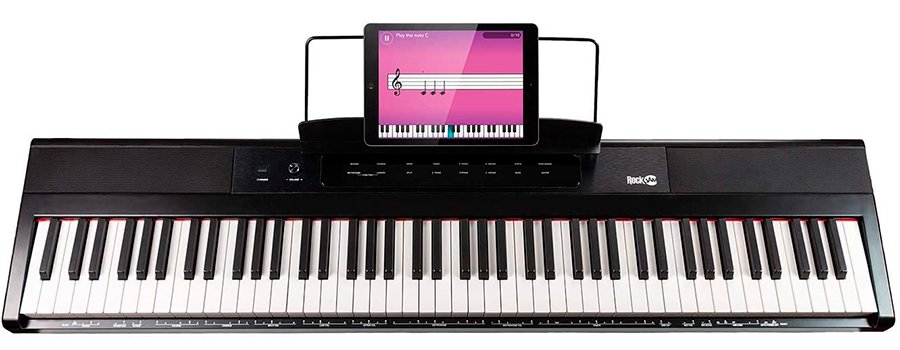
This instrument has a simple design reminding of the digital pianos both visually and to the touch. In fact, it’s probably the best 88 key keyboard under 200, while the semi-weighted keys and the austere assortment of functions mightn’t be a good fit for the professional musician or DJ.
The keys have good action and respond naturally to the touch. Certainly, there’s no pressure sensitivity in the lower position or aftertouch effect while the general dynamics and feel of keys is quite natural.
This digital keyboard has multiple inputs and outputs. There’s the MIDI out port, the USB, headphones connection, inputs for three types of pedals (sustain, soft, and sostenuto ones), microphone port. The various non-MIDI devices like the recording disk or mixer, can be connected via the AUX jack as well. The latter provides the stereo signal and lets record the sound in high-quality formats.
The functions of the buttons and faders in this 88 key piano are performed partially via the touch screen and by the keys themselves. While this requires interruption during playing to adjust certain parameters, the most popular ones (tones, rhythm, effects, voices) are regulated via the screen immediately. The latter is wide and is well visible thanks to the LED lights under the chosen parameter. I especially like the lesson mode and the split one, as well as the 20 voices assortment provided by this keyboard.
Pros
- Built-in 24W stereo speakers provide a quality stereo sound.
- The integrated Simply piano software goes well with both Windows and iOS; lets learn piano playing through a game.
- Includes the sheet stand that fits for paper note sheets and tablets.
Cons
- Doesn’t work with Android devices.
- Speaker vibration is heard at a high volume level.
Alesis Recital — Best 88 Key Keyboard for Beginners
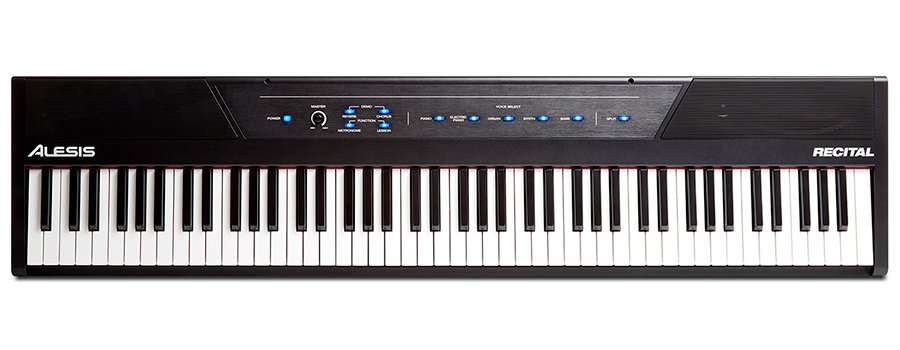
The number of functions and features in this digital piano is quite diverse but not overwhelming. It’s also easy to learn thanks to the smart design of the semi-weighted keys. The interface is simple to interact with, the modes are comprehensive. This might be the best 88 key keyboard save for the absence of the record mode.
The keyboard is well portable. It can be powered directly from the outlet via the power adaptor or work from the 6 D batteries. Other comfort features include the big sheet stand with the support stripe in the lower part. The effects are minimal including Chorus and Reverb ones. There are 5 voices including Organ and Bass modes, and the Split mode to assign the voices to the different parts of the keyboard.
The keys are equipped with the touch response technology that can be regulated to fit best for the current purpose and style of play. This 88 key keyboard integrates the sound module and provides several options for the sound output. First, it has quite powerful and clean 20W speakers. Second, it can be hooked up to the external speaker or an amp through RCA cables. Third, a headphone jack lets you hear a sound through the headphones while playing.
Pros
- Each mode, effect, and voice has its own button with an LED backlight.
- The connection to the Android tablet via the USB input was lagless and solid.
- Diverse polyphony lets play complex tunes and parties.
Cons
- The advanced settings (like min / max volume) are controlled by the keys and can be inadvertently activated.
- The sound becomes more synth-like in the top octaves.
Yamaha P71 — Best Weighted Keyboard with 88 Keys
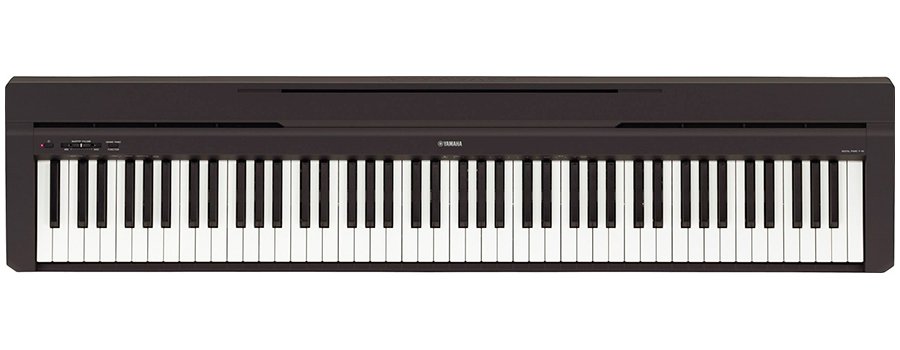
The full-size keys on this keyboard are built to provide more resistance in the low-end part of the keyboard, with the gradually higher sensitivity in upper registers, which is provided by the Graded Hammer Standard technology. Overall, the piano is responsive and has lively dynamics. The included sound module is lagless and creates the sound once the key is touched upon. It could be the best 88 key weighted keyboard if only the majority of the functions (effects, modes, metronome, etc.) wouldn’t be assigned to the keys directly. This requires all the changes to be made prior to the playback.
The user interface is quite scarce but comprehensive. There are three buttons on the upper part of the keyboard: Power on (with the LED indicator), Master volume slider with marked volume levels (while the volume can also be adjusted with the piano keys), and the “Grand piano / Function” button to switch between the modes and activate the effects and other settings.
The P71 88 key digital piano offers 10 different voices, 5 functions including the Transpose and Fine tuning mode, and Reverb effect with four subtypes (Room, Hall1, Hall2, and Stage). The sound produced by this keyboard is clear and noise-free while lacking some diversity of harmonics. Still, it’s quite sufficient both for the beginner play and the majority of professional applications (background accompaniment, music writing, and editing, etc.).
Pros
- The specific dual mode lets combine two different instrument voices during playback.
- I appreciated the precise sensitivity modes with diverse options (fixed / soft / medium / hard).
- Sophisticated AWM technology provides for clear and full sound samples.
Cons
- No MIDI port for DAW connection (USB only).
- The sheet stand tilts backwards and doesn’t let put the keyboard closely against the wall.
M-Audio Keystation 88 MK3 — Best 88 Key Digital Piano
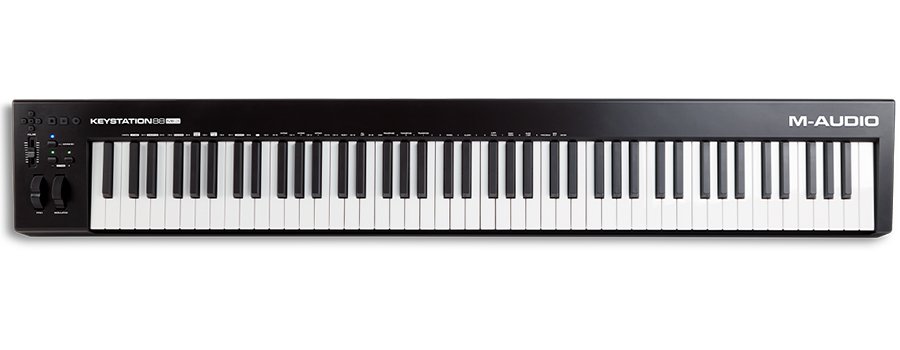
If you need a universal piano keyboard for music recording, mixing, beat making, and so on, the 88 MK3 might become the best 88 key MIDI keyboard. It features all the necessary DAW controls, has the full-size keys, and offers USB and MIDI connectivity, as well as versatile software options. However, it’s semi-weighted and not too responsive (though the keys possess the velocity feature).
The control panel includes the customizable volume fader, DAW-navigation buttons, octave regulators, mod and pitch wheels. All the knobs are performed solidly and don’t slide under the fingers. The navigation is quite simple. A part of the functions is performed via the piano keys. The DAW is easy to control thanks to the flexible function assignment that lets browsing through the DAW parameters and modify each one with ease.
Connections of this keyboard include two ports for sustain and effect pedals, the USB-MIDI port, and the regular five-pin MIDI jack. The PC connection is plug-n-play, as the keyboard is recognized immediately and the relevant software opens up without prior driver installation. This feature marks the keyboard as the best 88 key weighted MIDI controller. Still, the hookup to iOS devices requires a specific USB adapter.
The software on board includes Ableton Live Lite for recording and soundwork, the MPC Beats for beat making, and the ProTools First edition from M-Audio. This package includes several apps and offers 88 key controller tools both for beginners and pros.
Pros
- The digital panel offers six different instruments with multiple sounds and over 50 tool kits.
- The buttons are easily customizable to the VST kits.
- The nice slightly textured surface of the keys.
Cons
- No screen.
- The USB cable is rather short and requires close placement to the PC / laptop.
Alesis Recital Pro
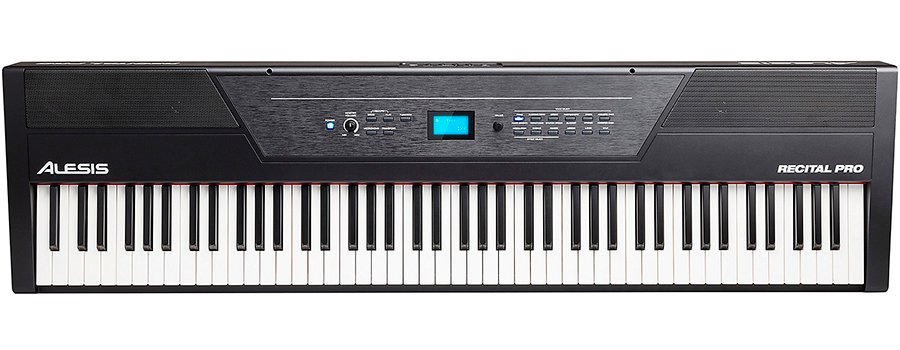
Advertised as an education instrument, this 88 key piano keyboard has a solid build and is loaded with features making it a good choice for a professional digital pianist as well. It has a full-size keybed with the hammer action system and comprehensive software controls. It can connect to a variety of sound production and editing devices like mixers, amps, recorders, and so on. The instrument itself is sturdy, with the keys and all the knobs being smooth but non-slipping, and easy-to-find. The keys have the pressure regulation system letting adjust the response to the player’s liking.
The controls have a convenient layout and provide a comprehensive system. The volume is represented by the knob with marked level values. The function and demo modes have their own buttons, as well as the metronome and transpose function. On the right part of the panel, there are 6 buttons standing for 12 voices, 3 effect buttons (Modulation, Chorus, and Reverb), and other modes (Lesson, Layer, and Split). Each parameter can be tweaked with the Value knob on the left. Besides, it’s easy to control the current parameter on the small central screen with a blue backlight.
The back panel has a USB input for a quick hookup to the tablet or a PC or another device. The transmission speed is fast, and the connection is solid. The ¼-inch jack lets connect various sound gear while the headphones have their own port. This 88 key keyboard with weighted keys has a connector for the sustain pedal as well.
Pros
- Lets record the sound directly during playback.
- Smooth effect modification; no abrupt changes.
- When activated, the relevant button is backlit with the blue light.
Cons
- No voice change was allowed during the recorded playback.
- The volume isn’t high even at the maximum level.
Yamaha P125
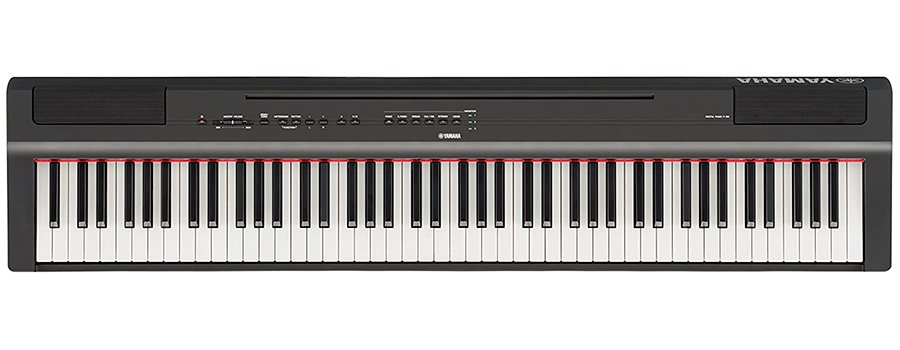
Looking for the instrument to learn or practice piano, that would sound good, feel natural, and have the MIDI capability? The P125 MIDI keyboards 88 key from Yamaha will have a tick for all those boxes. It represents a keyboard matching the size of the acoustic piano and feels in many ways like it. It has an integrated sound module and powerful speakers but can also connect to the external speakers and be managed through the smartphone app.
The keys on this 88 key MIDI controller look and play much like the live acoustic instrument. They’re fully weighted and feature the GHS technology, which ensures that the sensitivity increases gradually as the frequency increases. The surface of the keys is slightly abrasive yet not sharp, and the hammer-loaded keybed lets reach a certain effect just with the harder or milder pressure on the keys. There’s also an option to set the keys resistance rate between four options with regard to the player’s purpose and the chosen style. The built-in sound engine evokes the sound of the Yamaha grand piano. The sound features a lot of detail and clarity thanks to the 192 max polyphony applied.
The P125 Yamaha 88 key digital piano offers 24 presets for the instrument voices and four effect types (Reverb with four subtypes, Damper Resonance, IAC, and Sound boost). There are Split and Layer functions letting you play different voices with each hand. Other functions include a metronome, octave transposing, tuning, and tempo range regulation.
Pros
- The built-in 7W speakers disperse the sound in two directions creating the full stereo effect.
- The software includes 50 preset piano tunes and 21 demo ones.
- Wide tempo range: from 5 to 280.
Cons
- The string sounds have a lot of digital aftertaste.
- The supplied sustain pedal is small and feels flimsy.
Yamaha P45
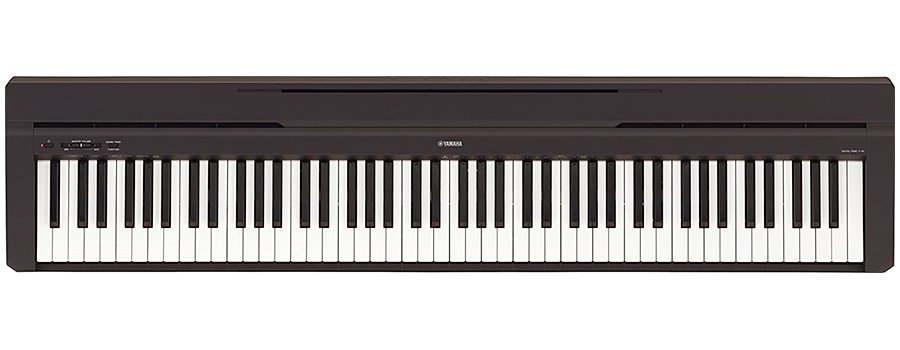
The basic set of features in this 88 key electric piano is compensated with the solid build of the instrument. The keyboard has 88 full-size keys laid out on a hammer action system and regulated with the GHS technology. There’s also the possibility to adjust the pressure sensitivity and make the keys more responsive for the fast playback or make them resist stronger to provide a more authentic and acoustic-close feel.
The presets include ten voices while the main sound is produced by the AWM sampling and provides the stereo sound of the stage grand piano. The effects palette contains four Reverb types that differ by the acoustic properties (these are Stage, Hall1, Hall2, and Room ones). The supported modes include the Layers one letting split the keyboard between two voices and the Duo mode. The metronome, tuning, and transposing functions are also available through the control panel and the relevant keys.
Controls are minimal but easy to master. There’s a power-on button, volume fader, and Function / Grand piano button. All the modes and effects are activated through the assigned keys, which are marked with the relevant inscriptions above them.
Speakers on this Yamaha 88 key keyboard are also basic, providing the 6W stereo output. Still, the sound is clean and well heard within a small or middle-sized room. Connections include the power plug, the headphones jack, the sustain pedal connector, and the USB input connecting the keyboard with a PC, laptop, or synth device.
Pros
- The preset voices sound natural and dynamic.
- The sheet stand is big and has a closed back for a fixed sheet / tablet position.
- Black keys are covered with a non-slippery matte finish.
Cons
- Polyphony isn’t diverse featuring 64 notes max.
- No AUX port for external speakers or other non-USB powered devices.
Donner DEP-20
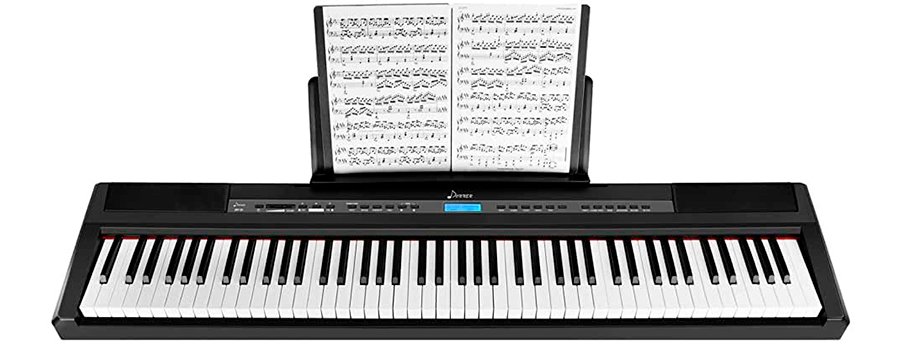
Looking for a solid MIDI keyboard with 88 keys size with the developed presets and functions assortment complete with the acoustic-grade response? The DEP-20 might be the end of your search. It has full-size keys and features a fully-weighted system providing the close-to-acoustic piano feel.
The digital piano has the sound module reproducing the natural acoustic piano sound by default. There are 238 voice presets representing multiple instruments like violin, ukulele, synthetic bass, etc. The rhythms section is also diverse, letting choose among 200 options. The polyphony is 128 notes max enabling the detailed audio output with clear low- and high-end and rich mids.
The keyboard is equipped with the 25W speakers and has the recording module. There are also 100 demo songs to choose from, with the possibility of simultaneous play. The FX panel consists of the Chorus and Reverb effects. The digital piano supports the Dual mode splitting the keyboard into two separate zones, each assigned to a certain voice. The education mode is easy to follow even for the starter pianists. The majority of functions and presets have their own buttons on the control panel, and the LED screen lets control the status of the current parameter or mode.
The connectors of the DEP-20 88 key MIDI controller include the audio input and output, two headphones connection, 2 pedal ports (for sustain and triangle pedals), the USB-MIDI port, the MP3 socket, and the DC port.
Pros
- Records the clear audio in the MP3 format.
- The chord play has two options (single finger and multi finger), with the possibility of automatic identification.
- The included pedal is made of zinc alloy and feels sturdy.
Cons
- Only a single track can be recorded and stored at a time.
- The manual is too basic and doesn’t explain many of the functions.
M-Audio Keystation 88 II — Best 88 Key MIDI Controller
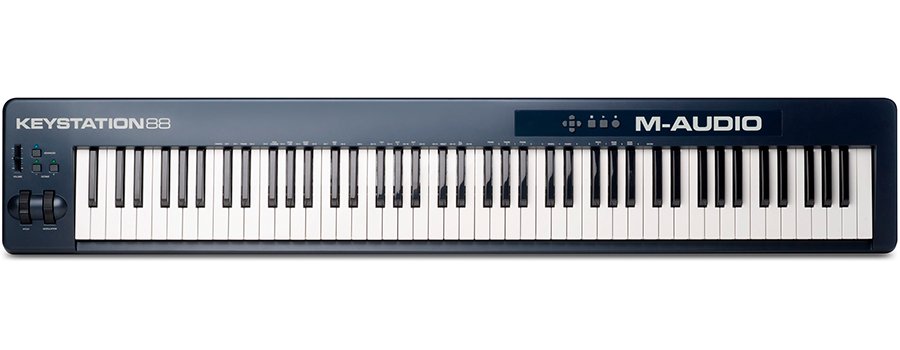
The slim design of this MIDI keyboard makes it a good traveling option. It can connect to Windows or iOs directly, has multiple software options with tool kits and audio samples, and intuitive navigation. It’s compatible with the majority of DAWs and has diverse functionality. It makes a handy tool for various digital music professionals including DJs and composers.
The sound regulation controls are located on the left panel and include the customizable volume fader and “Advanced” button, the octave transposition buttons. The latter work quickly and let embrace the extreme frequencies, e.g. for lead or string sound. The pitch and mod wheels have a good response and regulate the chosen mode (e.g. vibrato) with precision. The DAW controls (transport and navigation buttons) are situated on the right, above the keys.
The keybed is solid and contains 88 keys with a semi-weighted mechanism and velocity sensitivity. The keys can also function as the parameter regulators. The software kit for this model includes the Eighty Eight Ensemble voice kit for the 9-foot grand piano, which provides a natural and spacious sound. For the DAW management, there are Xpand!2 kit, Pro Tools, and other tool kits. This M-Audio 88 key MIDI controller maintains driver-free compatibility with PC and Mac, making it a plug-n-play device. It can be connected via the USB-MIDI, the dedicated MIDI port. There are also two-pedal connections and the power port.
Pros
- Includes the diverse Touch Loops sample sets for 2Gb.
- The USB port can be used as a power connection.
- The education software kit from Melodics is user-friendly and has a simple interface.
Cons
- The On/Off switch isn’t easy to reach on the back of the keyboard.
- The sensitivity of the white and black keys is slightly different.
Buying Guide
How Long is an 88 Key Keyboard?
The actual parameters of the 88 key piano boards vary with different manufacturers and models. The keyboard width depends on the size of the keys: it’s less with the smaller traveling keyboards and bigger with the full-size ones. The location of the controls and the space taken by them also matters. Generally, the keyboards with 88 keys have 48 – 52-inch length.
Key Points for Picking the Best 88 Key MIDI Controller
Before buying the 88 key MIDI keyboard pay attention to the following things:
- A sound module. The dedicated MIDI keyboards usually don’t have one and thus, can be heard via the external speaker system connected to a PC or a DAW. However, many of the modern MIDI keyboards have their own sound and speakers. Apart from being convenient, it also makes them heavier and more expensive.
- The comfort of play. The feeling of the semi-weighted and graded hammer keys differs. However, for music creation and editing, there might be no need for the pressure sensitivity. Play a few passages on the keyboard and estimate how smooth are the keys, whether they are easy to play, and if the controls are quick and intuitive.
- A number of controls. More controls mean more functions. However, the majority of the functions are usually left overlooked. Consider if you need a wide assortment of functions and controls, or the simple three-to-eight buttons interface is enough.
- Software and specific mechanisms. Metronome, voice kits, and DAW tools are great to have if you need them. However, the more complete the tool kit is, the higher the price.
- Connections. Think of the setup you’re going to use the keyboard in. Maybe you need a bus-power USB for on-stage performance or travel play. Or multiple pedal ports. Or a high-bandwidth MIDI connection to the DAW. Bluetooth can be a handy solution as well.

Hi everyone! I’m Thomas Moody, also known as Guitarzan.
